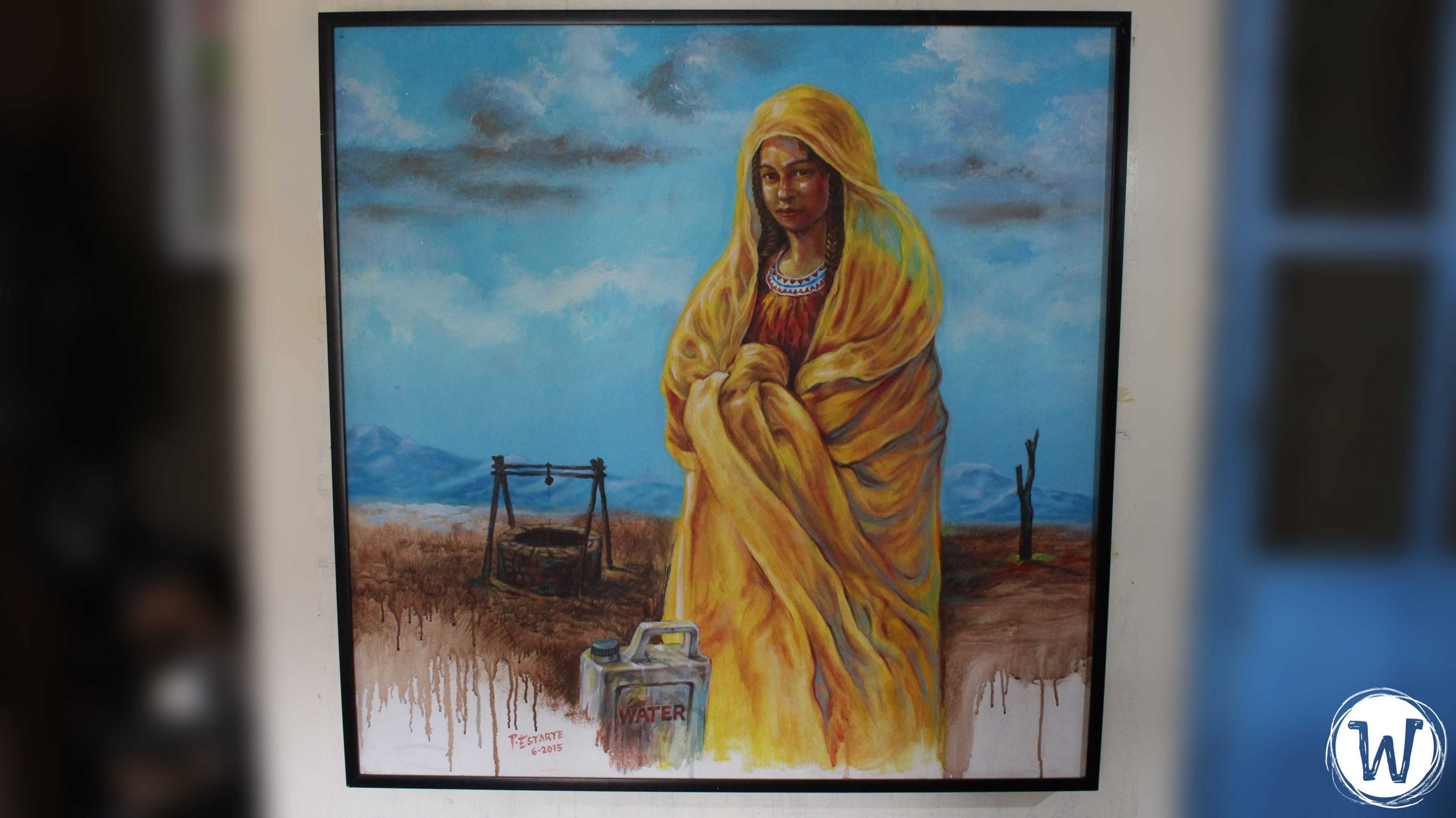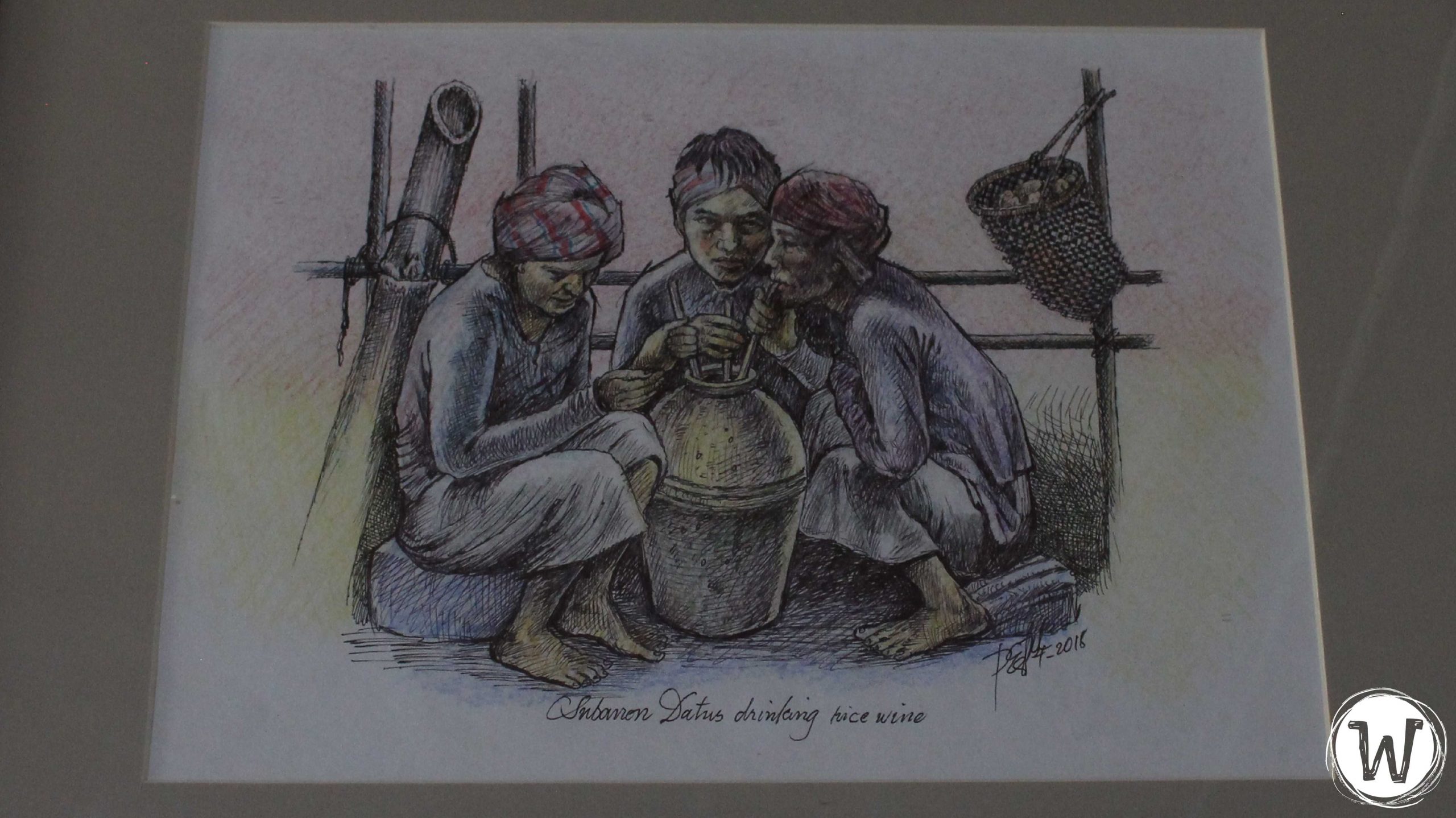To conclude the arts month celebration,
WhatALife features a renowned veteran artist, who has spent most of his life dedicated to creating visual illustrations of the Mindanao culture. Aside from that, he has also uplifted young aspiring artists through his art exhibits and workshops.
Pennessencio C. Estarte, also known as Nonoy, was born and raised in Zamboanga Sibugay in the 1950s. His efforts as an artist painted a place for him in the City of Golden Friendship in late 1970.
Check out and discover how a tiny matchbox kick-started his whole artistic journey.
Silt as his first canvas
Nonoy was five when he first discovered the wonder of creating images from mere shapes. He and his playmates would hangout underneath nipa houses with high
tukod (diagonal post). Soon after, he met
Rizal—not the National Hero but a brand of
posporo (match). This became his first muse, copying Jose Rizal’s image into the ground. Eventually, he discovered charcoal. From soil, he began doodling figures into their house’s walls and floor.
If you used to do this when you were young, you would know the feeling when young Nonoy got scolded by his mother because of the
mess he made.

His love for art and his foundation was soon developed through the help of his art teacher and an American Peace Corps Volunteer artist during his grade school years. There he learned to use other tools such as pencil, watercolors, and paint. Meanwhile, in his teens, Nonoy dedicated his time doing murals and painting jobs at his parish church and occasionally, for Jeepney exterior painting. At one point, he became a commercial artist. It was an election and politicians needed artists since tarpaulin and other printing machines were yet to exist. He drew images of both local and national politicians on plywoods using enamel paints.
Despite being unable to proceed and earn a degree, Nonoy continued learning through reading tons of books and looking up to renowned Filipino artists like Fernando Amorsolo, Guillermo Tolentino, and Jericho Vamenta, to name a few.
“When I was in the stage of learning, what I did was to really explore—to study since [I’m a] self-taught artist. I read a lot of books and research about other artists,” Nonoy recalled.
Becoming a professional artist
In 1972, when Martial Law was declared, Nonoy took a risky job of becoming the head of mass media in his province. Since the administration suppressed the flow of information, the church developed a so-called Blackboard Newspaper. Nonoy went to Cebu, along with a couple of priests from all over the Philippines, to train on the project that lasted for a year. In this period, he enhanced his skill as an illustrator and cartoonist.
Nonoy’s passion went further when Fr. Frank Demetrio, SJ of Xavier University took him under his wing. At that time, Demetrio was overseeing the development of Museo de Oro, and he needed an artist. The offer paved a more professional career for Nonoy as an artist.
During his time in the museum, Nonoy was given a chance to attend various training, and spent many hours of research and studying. He was also fortunate to work on the field, be exposed to different ethnic groups, and observed them before documenting it via illustrations or paintings. Moreover, it was there when he realized how important culture is and how it should be preserved.
Even with his improvement and the recognition he got from the community, Nonoy chose to remain off the artistic limelight. “
Dile kaayo ko ga join
ug mga National competitions. I don’t know why maybe because
ang akong pagtuo kay ‘I should stay in Mindanao; I should develop and serve Mindanao as an artist,’
para naa pod sense of artistic feature [diri],
di lang from outside (Mindanao),” Nonoy said.
(I seldom join National competitions. I don’t know why, maybe because I believe that
‘I should stay in Mindanao. I should develop and serve Mindanao as an artist,’ so that we will have a sense of artistic feature here, not just from outside Mindanao.)

Some of his cultural artworks were sent to an exhibit in Munich, Germany during the Philippine Summer Festival, which was then moved to another exhibit in Delf, Netherlands in the 1980s.
Other works and contributions
He spent 30 years as a resident artist at XU before retiring. During his active years, he co-founded visual arts organizations together with fellow veteran artists in the city. One of the organizations he built was the junior Artist Club in XU, which we know now as Circulo de Arte.
Aside from that, Nonoy also created cover book designs including the books of Fr. Demetrio. Historians in the university as well hired him to do their cover and book illustrations.
He then added that besides assuring themselves by having enough knowledge of their crafts, artists should also determine what they can contribute to the community. At the same time, don’t forget the reason why you paint in the first place.
“First of all, this is my enjoyment. This is my way of expression,” and that’s the most important matter for him. Art for him is a fulfillment, a purpose he had served most of his life.
“Every single drawing or painting is a statement, record, document—that all comes from the mind, a reflection of one’s experience in the community, in life. Just like my paintings were the reflection of my experience from my immersions. I won’t be able to create those if I didn’t go to the field.”
Nonoy continued by sharing his memorable immersion experience that was when he went to Lapuyan, Zamboanga del Sur where he witnessed the life of the Subanen native and their famous
Buklog ritual.

In 2013, Nonoy got sick and was prohibited from using harmful painting materials such as oil paints and enamel. Today, he only uses pen and ink, as well as acrylic paint and watercolors.
On average, Nonoy usually takes 1-4 days to create his pieces. However, this is the painting time alone. Research and other necessities during the art process (pre-painting) might take weeks or months.
To the young generation and aspiring artists
When asked what is his message to the aspiring and rising artists, Nonoy advised:
“…to
study more and
don’t stop developing your skill—observe artist friends, attend exhibits, and read books as much as possible.”
“And when you draw something, dile ka mag drawing para mahimong kang popular or to please other people, no.
You draw because you believe this is your expression, your message. At the same time, this is a gift.
Dile ni siya mahimong gift
kung dile nimo ma transmit,
di nimo siya mapuslan.”
(And when you draw something, do it not for fame or to please people, no. You draw because you believe this is your expression, your message. At the same time, this is a gift. It won’t be a gift if you can’t transmit it, it would be worthless. )
He also encourages artists to
go out into the world and to
explore and see different characters from different cultures and people. Nonoy believes that armchair artists should not limit themselves to that chair. They should
go out to broaden their horizons—visit places, listen to stories, and make dialogue with people. Then, incorporate these experiences into art pieces.
—
Nonoy and other amazing local artists in Northern Mindanao have an ongoing art exhibit at Xavier University – Museo de Oro as part of the
Xavier Arts Festival 2020,
until March 12. Check it out!
 His love for art and his foundation was soon developed through the help of his art teacher and an American Peace Corps Volunteer artist during his grade school years. There he learned to use other tools such as pencil, watercolors, and paint. Meanwhile, in his teens, Nonoy dedicated his time doing murals and painting jobs at his parish church and occasionally, for Jeepney exterior painting. At one point, he became a commercial artist. It was an election and politicians needed artists since tarpaulin and other printing machines were yet to exist. He drew images of both local and national politicians on plywoods using enamel paints.
Despite being unable to proceed and earn a degree, Nonoy continued learning through reading tons of books and looking up to renowned Filipino artists like Fernando Amorsolo, Guillermo Tolentino, and Jericho Vamenta, to name a few.
“When I was in the stage of learning, what I did was to really explore—to study since [I’m a] self-taught artist. I read a lot of books and research about other artists,” Nonoy recalled.
His love for art and his foundation was soon developed through the help of his art teacher and an American Peace Corps Volunteer artist during his grade school years. There he learned to use other tools such as pencil, watercolors, and paint. Meanwhile, in his teens, Nonoy dedicated his time doing murals and painting jobs at his parish church and occasionally, for Jeepney exterior painting. At one point, he became a commercial artist. It was an election and politicians needed artists since tarpaulin and other printing machines were yet to exist. He drew images of both local and national politicians on plywoods using enamel paints.
Despite being unable to proceed and earn a degree, Nonoy continued learning through reading tons of books and looking up to renowned Filipino artists like Fernando Amorsolo, Guillermo Tolentino, and Jericho Vamenta, to name a few.
“When I was in the stage of learning, what I did was to really explore—to study since [I’m a] self-taught artist. I read a lot of books and research about other artists,” Nonoy recalled.
 Some of his cultural artworks were sent to an exhibit in Munich, Germany during the Philippine Summer Festival, which was then moved to another exhibit in Delf, Netherlands in the 1980s.
Some of his cultural artworks were sent to an exhibit in Munich, Germany during the Philippine Summer Festival, which was then moved to another exhibit in Delf, Netherlands in the 1980s.
 In 2013, Nonoy got sick and was prohibited from using harmful painting materials such as oil paints and enamel. Today, he only uses pen and ink, as well as acrylic paint and watercolors.
On average, Nonoy usually takes 1-4 days to create his pieces. However, this is the painting time alone. Research and other necessities during the art process (pre-painting) might take weeks or months.
In 2013, Nonoy got sick and was prohibited from using harmful painting materials such as oil paints and enamel. Today, he only uses pen and ink, as well as acrylic paint and watercolors.
On average, Nonoy usually takes 1-4 days to create his pieces. However, this is the painting time alone. Research and other necessities during the art process (pre-painting) might take weeks or months.

Leave a Reply